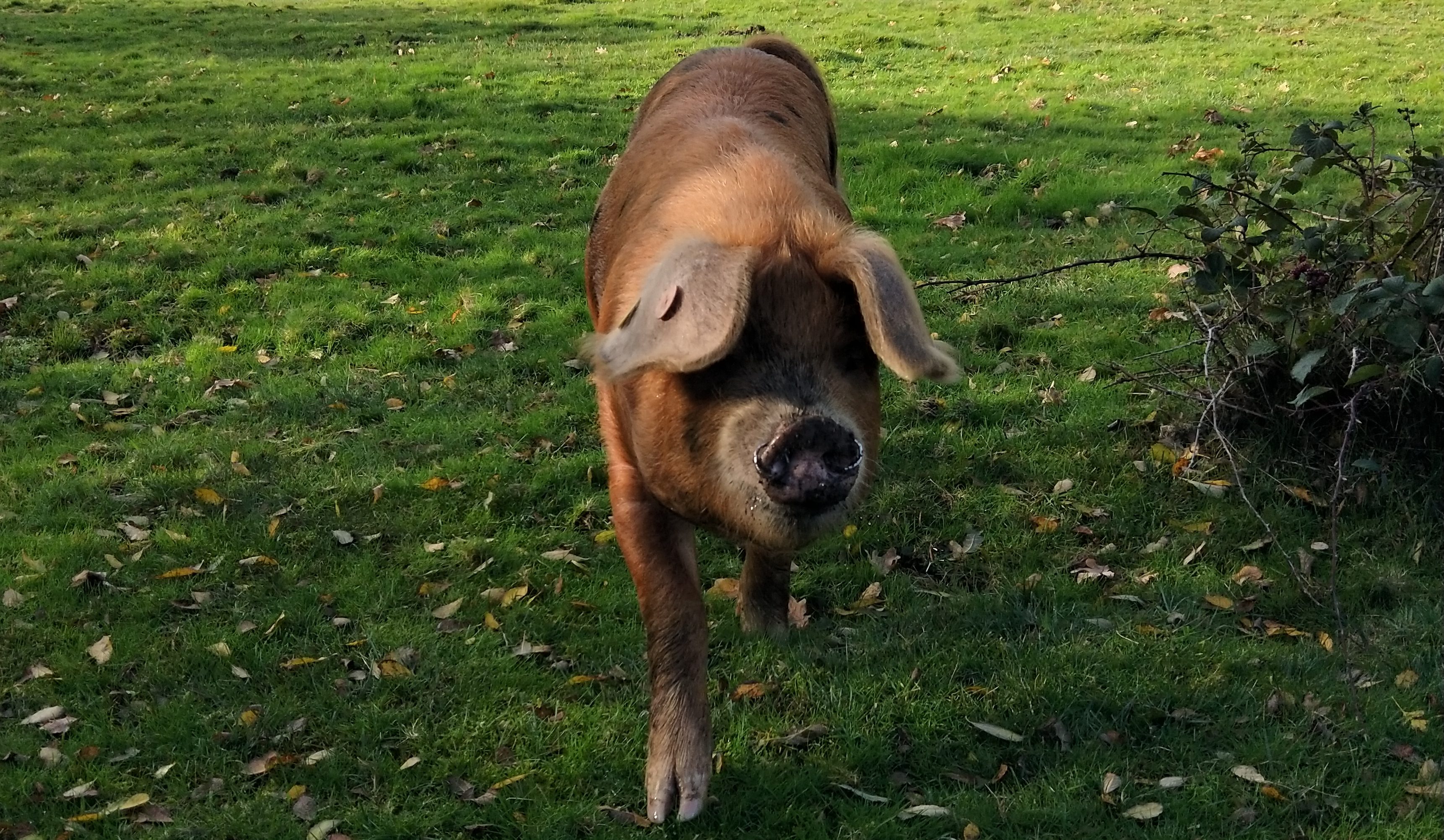 Staff Volunteer UpdatesVolunteer Profile: Denise HurdenMonday 2nd December 2019Learn More
Staff Volunteer UpdatesVolunteer Profile: Denise HurdenMonday 2nd December 2019Learn More
Uh Oh! You're using an old web browser
Please upgrade to a modern web browser to view this website.
Description
Wednesday 23rd November 2022
Pigs on pannage
I arrived at the New Forest with the idea of ponies galloping through the heathland, cattle meandering through green pastures and donkeys munching on garden hedges. However, I seemed to overlook the floppy-eared, curly-tailed foragers that make their appearance each autumn to hoover up the acorns (which are poisonous to New Forest ponies and cattle), namely, the pigs.
I soon learnt that this ancient practice whereby commoners turn out their pigs to roam the forest is known as pannage and is premised on the commoners’ right, Common of Mast. Pannage lasts for at least 60 days usually from late September to December but it is the Verderers and Forestry England’s responsibility to establish the exact dates of pannage depending on seasonal factors such as the amount of mast (the fallen fruit of forest trees and shrubs) that year.
Imagining pigs galivanting under ancient oaks and eating their way through the forest, I felt worlds away from the wombats and gumtrees back home and was left with a myriad of questions. Firstly, how are these pigs being monitored?
I was soon to find out…
We arrived at the pig pens where two Oxford Sandy and Black breed pigs squealed in excitement. Only 8 months old, these pigs were as new to pannage as I was. With a bell in one hand and a bucket of pig pellets in the other, it was training time. We let them out of the pens in an enclosed space and began by peppering the enclosure with pallets and ringing the bell.
Not unlike training a small child or a dog, we attempted to condition the pigs to associate the bell with a reward (food) in the hopes that, eventually, by merely ringing the bell we could summon the pigs.
Now that we had trained these playful youngsters, it was time for their grand pannage debut. Our commoning mentor Erika had selected one of the finest patches of land, it was a wonderland of forest fodder complete with a glut of acorns and cosy spaces to curl up and sleep off a food coma – what more could a pig want!
Lost in the lines of pig-human communication, it appeared that there was something else these pigs were after: the neighbours’ garden.
These pigs were proving that pannage wasn’t all acorns and amiability.
But hey, it could’ve been worse! Without the rings in their noses that garden would have been akin to muddy swamp. Metal nose rings are a requirement for New Forest pannage pigs. They allow pigs to forage through leaf litter and mast without damaging the forest by annihilating the earth with their snout. So, for now, it was just poorly pruned flower beds and garden lawns criss-crossed with hooves (all accepted graciously by the property owner!).
With two blissfully unaware but disobedient pigs, it was back to square one.
After more training and encouragement from Erika and agister Robert not to give up, our woodland warriors were loaded up and chauffeured off to their new pannage base: Ran’s Wood.
They seemed to take a liking to the sea of acorns and ample play space that Ran’s Wood has to offer; pannaging by day, resting in the shelter of a large oak by night, they never wandered too far from their post.
For those first few weeks, the occasional trips to Hatchet Pond seemed to suffice their adventurous impulses. I don’t doubt they posed for tourists and – to our concern for both the pigs’ health and the tourists’ fingers – turned up their snouts to the acorns, favouring hand-fed sandwiches instead. Nonetheless, regular checks from CET staff and a community network eyes and ears ensure the pannage pigs can roam with reduced risk and visitors can be educated about the damage that can be caused by feeding forest livestock.
It feels as though I have stepped into the muddy midst of a chaotic and exciting corner of the world where I can wake up, open my bedroom blinds and find two pigs trotting past by bedroom window. No, I am not dreaming, I tell myself, this is just another day of pannage in the New Forest.
I would like to thank all the wonderful community members who have helped keep an eye out for our pigs, kindly notifying us of their whereabouts and activities when we had begun to suspect they had wandered into the depths of the forest. Thank you Erika for your ongoing patience, insight, and support. Finally, a huge thank you to my fellow staff at the CET for all your hard work — and continually putting up with my many questions regarding all things pannage!
References and further reading:
https://www.newforestnpa.gov.uk/discover/commoning/the-animals/pigs/
https://oxfordsandypigs.co.uk/
https://www.thenewforest.co.uk/explore/wildlife-and-nature/pigs






